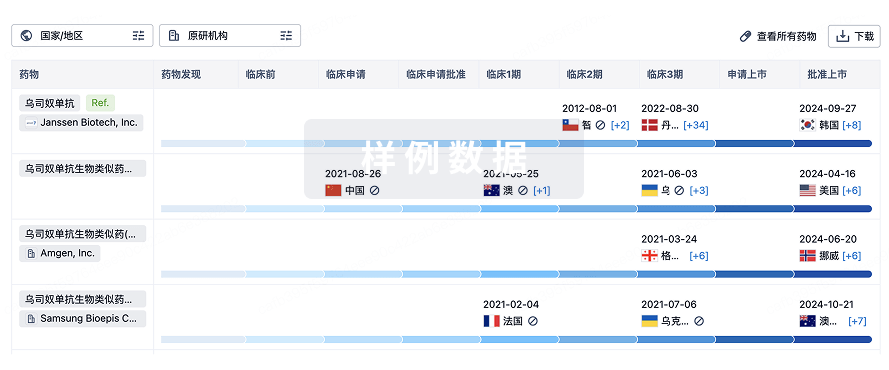预约演示
更新于:2025-11-07
Mycobacterium tuberculosis derived antigens(Vakzine)
更新于:2025-11-07
概要
基本信息
药物类型 重组蛋白 |
别名 rdESAT-6 / rCFP-10、Cy-Tb、Siiltibcy |
作用方式 调节剂 |
作用机制 结核分枝杆菌早期分泌性抗原调节剂 |
治疗领域 |
在研适应症 |
非在研适应症- |
非在研机构- |
权益机构- |
最高研发阶段批准上市 |
首次获批日期 欧盟 (2025-01-13), |
最高研发阶段(中国)- |
特殊审评- |
登录后查看时间轴
关联
100 项与 Mycobacterium tuberculosis derived antigens(Vakzine) 相关的临床结果
登录后查看更多信息
100 项与 Mycobacterium tuberculosis derived antigens(Vakzine) 相关的转化医学
登录后查看更多信息
100 项与 Mycobacterium tuberculosis derived antigens(Vakzine) 相关的专利(医药)
登录后查看更多信息
3
项与 Mycobacterium tuberculosis derived antigens(Vakzine) 相关的文献(医药)2023-05-03·Open forum infectious diseases
A Systematic Review on the Safety of Mycobacterium tuberculosis–Specific Antigen–Based Skin Tests for Tuberculosis Infection Compared With Tuberculin Skin Tests
Article
作者: Hamada, Yohhei ; Abubakar, Ibrahim ; Matveev, Aleksandr ; Wan-Hsin, Liu ; Ziganshina, Liliya Eugenevna ; Surkova, Elena ; Kontsevaya, Irina ; Ismail, Nazir ; Wang, Ting Ting ; Denkinger, Claudia M ; Korobitsyn, Alexei ; Rangaka, Molebogeng X
Abstract:
Background:
A systematic review showed that the accuracy of Mycobacterium tuberculosis antigen–based skin tests (TBSTs) for tuberculosis is similar to that of interferon γ release assay, but the safety of TBSTs has not been systematically reviewed.
Methods:
We searched for studies reporting injection site reactions (ISRs) and systemic adverse events associated with TBSTs. We searched Medline, Embase, e-library, the Chinese Biomedical Literature Database, and the China National Knowledge Infrastructure database for studies through 30 July 2021, and the database search was updated until 22 November 2022.
Results:
We identified 7 studies for Cy-Tb (Serum Institute of India), 7 (including 2 found through the updated search) for C-TST (Anhui Zhifei Longcom), and 11 for Diaskintest (Generium). The pooled risk of any injection site reactions (ISRs) due to Cy-Tb (n = 2931; 5 studies) did not differ significantly from that for tuberculin skin tests (TSTs; risk ratio, 1.05 [95% confidence interval, .70–1.58]). More than 95% of ISRs were reported as mild or moderate; common ISRs included pain, itching, and rash. In 1 randomized controlled study, 49 of 153 participants (37.6%) given Cy-Tb experience any systemic adverse event (eg, fever and headache), compared with 56 of 149 participants (37.6%) given TST (risk ratio, 0.85 [95% confidence interval, .6–1.2]). In a randomized controlled study in China (n = 14 579), the frequency of systemic adverse events in participants given C-TST was similar to that for TST, and the frequency of ISRs was similar to or lower than that for TST. Reporting of the safety data on Diaskintest was not standardized, precluding meta-analysis.
Conclusion:
The safety profile of TBSTs appears similar to that of TSTs and is associated with mostly mild ISRs.
Cadernos de Saude Publica
TB antigen-based skin tests and QFT-Plus for Mycobacterium tuberculosis infection diagnosis in Brazilian healthcare workers: a cost-effectiveness analysis
Article
作者: Trajman, Anete ; Maciel, Ethel Leonor Noia ; Souza, Fernanda Mattos de ; Prado, Thiago Nascimento do ; Steffen, Ricardo E ; Pinto, Márcia Ferreira Teixeira
This study aimed to analyze the cost-effectiveness of three tuberculosis (TB) antigen-based skin tests (TBST) (Diaskintest, C-TST, and Cy-TB) and QFT-Plus for TB infection diagnosis compared to the current standard of care, PPD Rt-23 tuberculin skin test (TST), among healthcare workers in Brazil. A state-transition Markov model was employed, simulating a cohort of healthcare workers (five annual cycles) for testing and treating TB infection with three months of weekly doses of rifapentine and isoniazid (3HP) under the Brazilian public health system perspective. Effects (TB disease averted) and costs for screening and treating TB infection were discounted at 5%. Incremental cost-effectiveness per TB averted was estimated. One-way and probabilistic sensitivity analysis were performed. Brazil, an upper-middle-income country with a high burden of TB, shows one of the largest universal public health systems and provides free-of-charge diagnosis and treatment for TB and TB infection. TST is the standard of care, whereas QFT-Plus is available for very high-risk populations. The three new TBST are under validation for eventual incorporation. Patients or participants: a hypothetical cohort of 10,000 healthcare workers, working at any level of healthcare service, and negative TST results in the previous year of both sexes with a baseline negative TST result. Diaskintest, C-TST, Cy-TB, and QFT-Plus were found to show a higher specificity. Costs with QFT-Plus were higher due to equipment, human labor, and test price. Diaskintest was the most cost-saving strategy, followed by Cy-TB for TB preventive treatment with 3HP. In the Brazilian scenario, Diaskintest and Cy-TB are the most cost-effective tests for sequential testing of healthcare workers.
International Health
Evaluating the cost-effectiveness of Cy-Tb for LTBI in India: a comprehensive economic modelling analysis
Article
作者: Rajsekar, Kavitha ; Tyagi, Kirti ; Padmapriyadarsini, Chandrasekaran ; Muniyandi, Malaisamy ; Nagarajan, Karikalan ; Mathiyazhagan, Kavi
Abstract:
Background:
Latent tuberculosis infection (LTBI) remains a significant challenge, as there is no gold standard diagnostic test. Current methods used for identifying LTBI are the interferon-γ release assay (IGRA), which is based on a blood test, and the tuberculin skin test (TST), which has low sensitivity. Both these tests are inadequate, primarily because they have limitations with the low bacterial burden characteristic of LTBI. This highlights the need for the development and adoption of more specific and accurate diagnostic tests to effectively identify LTBI. Herein we estimate the cost-effectiveness of the Cy-Tb test as compared with the TST for LTBI diagnosis.
Methods:
An economic modelling study was conducted from a health system perspective using decision tree analysis, which is most widely used for cost-effectiveness analysis using transition probabilities. Our goal was to estimate the incremental cost and number of TB cases prevented from LTBI using the Cy-Tb diagnostic test along with TB preventive therapy (TPT). Secondary data such as demographic characteristics, treatment outcome, diagnostic test results and cost data for the TST and Cy-Tb tests were collected from the published literature. The incremental cost-effectiveness ratio was calculated for the Cy-Tb test as compared with the TST. The uncertainty in the model was evaluated using one-way sensitivity analysis and probability sensitivity analysis.
Results:
The study findings indicate that for diagnosing an additional LTBI case with the Cy-Tb test and to prevent a TB case by providing TPT prophylaxis, an additional cost of 18 658 Indian rupees (US${\$}$223.5) is required. The probabilistic sensitivity analysis indicated that using the Cy-Tb test for diagnosing LTBI was cost-effective as compared with TST testing. If the cost of the Cy-Tb test is reduced, it becomes a cost-saving strategy.
Conclusions:
The Cy-Tb test for diagnosing LTBI is cost-effective at the current price, and price negotiations could further change it into a cost-saving strategy. This finding emphasizes the need for healthcare providers and policymakers to consider implementing the Cy-Tb test to maximize economic benefits. Bulk procurements can also be considered to further reduce costs and increase savings.
100 项与 Mycobacterium tuberculosis derived antigens(Vakzine) 相关的药物交易
登录后查看更多信息
研发状态
10 条最早获批的记录, 后查看更多信息
登录
| 适应症 | 国家/地区 | 公司 | 日期 |
|---|---|---|---|
| 结核 | 欧盟 | 2025-01-13 | |
| 结核 | 冰岛 | 2025-01-13 | |
| 结核 | 列支敦士登 | 2025-01-13 | |
| 结核 | 挪威 | 2025-01-13 |
登录后查看更多信息
临床结果
临床结果
适应症
分期
评价
查看全部结果
| 研究 | 分期 | 人群特征 | 评价人数 | 分组 | 结果 | 评价 | 发布日期 |
|---|
No Data | |||||||
登录后查看更多信息
转化医学
使用我们的转化医学数据加速您的研究。
登录
或

药物交易
使用我们的药物交易数据加速您的研究。
登录
或

核心专利
使用我们的核心专利数据促进您的研究。
登录
或

临床分析
紧跟全球注册中心的最新临床试验。
登录
或

批准
利用最新的监管批准信息加速您的研究。
登录
或

生物类似药
生物类似药在不同国家/地区的竞争态势。请注意临床1/2期并入临床2期,临床2/3期并入临床3期
登录
或

特殊审评
只需点击几下即可了解关键药物信息。
登录
或

生物医药百科问答
全新生物医药AI Agent 覆盖科研全链路,让突破性发现快人一步
立即开始免费试用!
智慧芽新药情报库是智慧芽专为生命科学人士构建的基于AI的创新药情报平台,助您全方位提升您的研发与决策效率。
立即开始数据试用!
智慧芽新药库数据也通过智慧芽数据服务平台,以API或者数据包形式对外开放,助您更加充分利用智慧芽新药情报信息。
生物序列数据库
生物药研发创新
免费使用
化学结构数据库
小分子化药研发创新
免费使用


